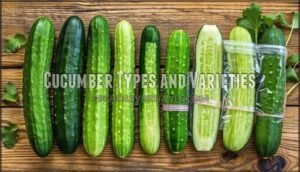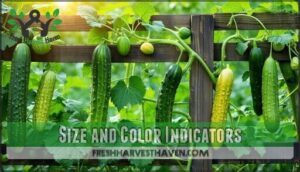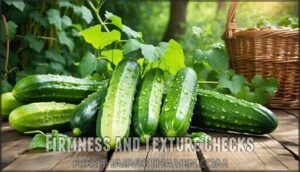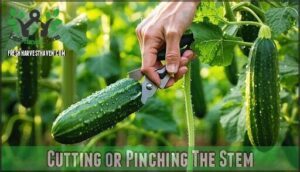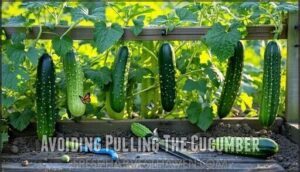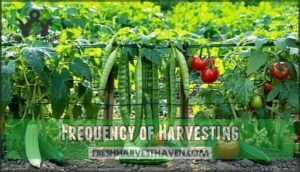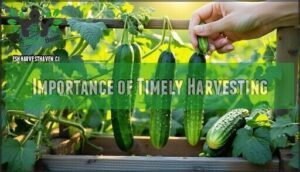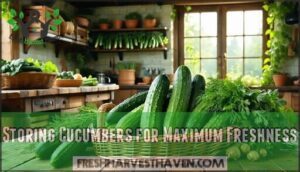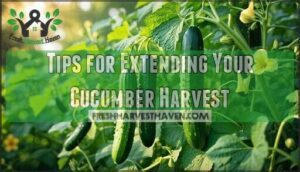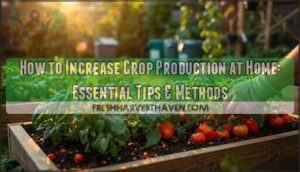This site is supported by our readers. We may earn a commission, at no cost to you, if you purchase through links.
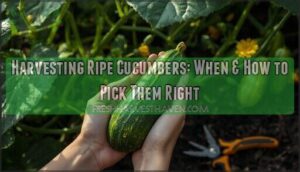
Check your plants every day or two to keep them producing. Frequent harvests stop cucumbers from going yellow, bitter, or full of seeds. Timing matters, but the real trick is learning what your plants are telling you through small changes in appearance and texture.
Table Of Contents
- Key Takeaways
- When Are Cucumbers Ready to Harvest?
- Essential Harvesting Techniques for Cucumbers
- Choosing The Best Tools for Harvesting
- Storing Cucumbers for Maximum Freshness
- Tips for Extending Your Cucumber Harvest
- Frequently Asked Questions (FAQs)
- How do I know when my cucumbers are ready to pick?
- What happens if you pick a cucumber too early?
- How long should cucumbers stay on the vine?
- How soon after picking cucumbers should you pickle them?
- Can you pick a cucumber too early?
- How do you harvest ripe cucumbers?
- How long does it take for cucumbers to ripen?
- When to harvest cucumbers?
- How do I ensure a successful cucumber harvest?
- How do you keep cucumbers from ripening?
- Conclusion
Key Takeaways
- You’ll get the best results by checking your cucumber plants every day or two during peak season, cutting the stems cleanly with sharp pruners about an inch above the fruit to avoid damaging the vine and reducing future yields. – Harvest timing depends on your cucumber variety—pickling types are ready at 1½ to 4 inches, slicing cucumbers peak at 6 to 8 inches, and specialty varieties like English cucumbers can stretch to 10–18 inches before quality drops. – Cucumbers that stay on the vine too long develop yellow color, bitter flavor from increased cucurbitacin, and hard seeds, while also signaling the plant to stop producing new fruit, which can cut your overall harvest by 20%. – Proper post-harvest storage at 50–55°F in your crisper drawer with moderate humidity keeps cucumbers fresh for 3 to 5 days, but temperatures below 50°F cause chilling injury with pitting and water-soaked spots within just three days.
When Are Cucumbers Ready to Harvest?
Knowing when your cucumbers are ready to pick means looking at a few key signs that tell you the fruit has reached its peak.
Let’s walk through the main indicators you’ll want to check before you start harvesting.
Here’s what to look out for so you know when it’s time to pick.
Cucumber Types and Varieties
Understanding cucumber types helps you know exactly when to pick them. The main categories differ in their best harvest timing and intended use:
Different cucumber varieties need different harvest windows. Pickling types like Kirby are ready at 1½ to 4 inches, while slicing cucumbers hit their sweet spot between 6 and 8 inches.
Specialty varieties each have their own timing.
- Slicing cucumbers and burpless varieties perform best when harvested between 6 and 8 inches, delivering fresh eating quality
- Specialty varieties include seedless types (English cucumbers at 10–18 inches), Persian mini cucumbers, and Armenian cucumbers, which can grow up to 36 inches but taste better picked before 18 inches
China leads global cultivation with over 20 million tons produced annually, while the United States yields approximately 1.6 million tons each year. Consider planting disease-resistant Diva cucumbers for a bountiful harvest and straight, dark green fruits. Knowing your variety’s characteristics ensures you harvest at the right moment for peak flavor and texture.
Size and Color Indicators
Once you know your variety, watch for the right size and color to appear on the vine—your cucumber will tell you it’s ready through these visible changes.
Best size varies by type: pickling cucumbers reach maturity at 2–4 inches, while slicing varieties show ripeness indicators at 6–8 inches.
Color variations signal cucumber maturity—most develop deep green skin, though some specialty types display yellow or white tints. Visual cues like uniform coloring across the fruit confirm you’ve reached the right ripeness stage for harvest.
Firmness and Texture Checks
A gentle squeeze tells you more than color alone—ripe cucumbers feel firm when you press them lightly with your thumb. Skin firmness and cucumber texture work together as reliable ripeness indicators, helping you identify ripe cucumbers before they pass their prime.
This tactile assessment helps you detect cucumber maturity through skin turgor, which reveals whether the fruit has reached proper ripeness. Soft spots suggest bruising or decay, while cucumber crispness comes through in that satisfying firmness.
When you press a cucumber, its firmness tells you a lot about how ripe it is. If you find any soft spots, that usually means there’s bruising or the cucumber is starting to spoil.
But when it feels crisp and solid, you know it’s perfectly fresh.
Signs of Overripening
If you miss the perfect moment, you’ll know fast—your cucumbers start showing clear trouble signs. Yellowing cucumbers signal overripeness, while seed development accelerates inside, creating hard, unpleasant centers that ruin cucumber flavor. These overripe cucumbers hurt future yields too, redirecting plant energy away from new fruit.
It’s obvious when you’ve waited too long—your cucumbers will let you know. As they turn yellow, it’s a sure sign they’re past their prime.
Inside, the seeds quickly get tough and take over, making the centers hard and unpleasant, and the flavor takes a hit.
Leaving these overripe cucumbers on the plant saps energy from new fruit, which means fewer cucumbers down the line.
- Color shifts from green to yellow or orange—yellowing cucumbers appear in over 80% of delayed harvests, signaling you’ve waited too long.
- Texture changes dramatically—the firm crispness disappears, replaced by sponginess that makes identifying ripe cucumbers easier by what to avoid.
- Bitterness increase becomes pronounced—overripe fruit develops unpleasant flavors as cucurbitacin concentrations spike during seed maturation.
The plant impact extends beyond single fruits. Leaving overripe cucumbers on vines can reduce overall yield by 20%, since your plant thinks it’s finished its job of making seeds. Sometimes, nutrient deficiencies can also contribute to this yellowing.
Essential Harvesting Techniques for Cucumbers
Proper harvesting technique protects both your cucumbers and the vine itself. Let’s look at the key methods that keep your plants productive and your harvest in top shape.
How you pick cucumbers matters. Use the right approach and you’ll protect the plant while getting better fruit.
Cutting or Pinching The Stem
Using sharp pruners or a knife to cut the stem is the best way to harvest your cucumbers without damaging the plant. Leave about an inch of stem attached to prevent rot during storage. Clean your garden shears between plants to avoid spreading disease—tool sterilization protects your entire crop. Whether you’re using the pinching technique or making a precise stem cutting angle, handle each fruit gently to prevent stem bruising.
| Cucumber Harvesting Techniques | Tool Type | Best Practice |
|---|---|---|
| Stem Cutting Angle | Pruners | Cut at 45° for clean separation |
| Pinching Technique | Fingers (small fruits) | Gentle twist, not pull |
| Desirable Stem Length | Garden shears | Leave 1 inch attached |
| Tool Sterilization | Any cutting tool | Clean between plants |
When you harvest ripe cucumbers this way, you’ll maintain plant health and extend your growing season.
Avoiding Pulling The Cucumber
Yanking cucumbers off the vine tears delicate stems and can uproot shallow feeder roots, setting your plant back for days or even weeks. This kind of vine damage causes unnecessary plant stress and reduces future yields.
If you just yank cucumbers off the vine, you can rip those delicate stems or even pull up shallow roots.
That kind of rough handling stresses your plant and can set back its growth for a week or more, meaning fewer cucumbers down the road.
When you harvest ripe cucumbers correctly, you’ll notice healthier, more productive plants throughout your cucumber harvest season.
Frequency of Harvesting
Check your cucumber patch every two to three days during peak season—this harvesting frequency strikes the best balance between yield optimization and labor costs. Market demand for fresh cucumbers requires consistent picking schedules, and this cucumber harvesting guide helps you maintain grade quality while maximizing returns. Your cucumber harvest thrives when you establish a regular routine for harvesting cucumbers at the optimum time.
Effective cucumber harvesting techniques depend on these intervals:
- Daily checks during hot weather prevent overripening and bitter fruit
- Every 2–3 days works well for most home gardens and small commercial operations
- Three pickings per week produces more Grade I cucumbers than weekly harvests
- Twice-weekly harvesting maximizes value per labor hour in commercial settings
- Frequent picking keeps plants productive by preventing resource drain from oversized fruit
Importance of Timely Harvesting
Timing your harvest right makes the difference between crisp, flavorful cucumbers and bitter, seedy disappointments that belong in the compost pile. When you pick at cucumber maturity, you get the most out of flavor and quality while keeping plants producing for weeks.
Pick cucumbers at their peak—firm, bright, and properly sized—to enjoy crisp flavor and keep your vines producing all season long
Pick cucumbers at just the right moment and you’ll enjoy crisp bites packed with flavor; miss that window and you’re left with tough, seedy duds headed for the compost instead.
Harvesting at peak maturity gives you the best taste while encouraging your plants to keep producing for weeks.
Choosing The Best Tools for Harvesting
Having the right tools makes harvesting cucumbers easier and keeps your plants healthy. Here are three reliable options that work well for cutting cucumbers cleanly from the vine.
You’ll need a few basic tools to harvest cucumbers without damaging the vine. A good pair of pruning shears, garden scissors, or a sharp knife will get the job done.
ComfortGEL Micro Snips Leaf Stem Orange
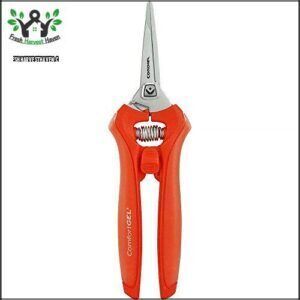
The ComfortGEL Micro Snips feature cushioned grips that reduce hand fatigue during extended harvest sessions, making them ideal for gardeners who need to pick cucumbers daily or every other day. These ergonomic snips deliver precise cutting when harvesting ripe cucumbers at best size, cleanly severing stems without damaging the vine.
The ComfortGEL grip stays comfortable even when handling prickly cucumber varieties.
Keep your snips clean between uses—simple snip maintenance with a quick wipe prevents disease transfer between plants and your cucumber harvesting techniques remain effective throughout the season.
Fiskars Multi Snip With Sheath

If you’re harvesting several dozen cucumbers in one go, you’ll appreciate the Fiskars Multi Snip‘s protective sheath—it keeps the sharp blades safely covered when you’re moving between rows or reaching into dense foliage.
The stainless-steel blade material resists rust even in humid garden conditions, and the ergonomic design reduces wrist strain when you harvest cucumbers frequently.
These pruners work well for cucumber harvesting techniques and alternative uses like trimming herbs, so they’re practical beyond your cucumber patch.
Fiskars Bypass Pruning Shears Garden Clippers
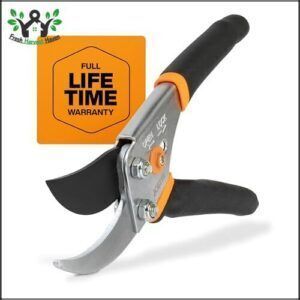
For larger cucumber plants or tougher vines, Fiskars Bypass Pruning Shears give you more cutting power without yanking on the plant. The ergonomic handle design reduces hand fatigue when you harvest cucumbers across multiple beds, and the shear blade quality stays sharp through repeated use.
These pruners offer practical advantages for cucumber harvesting techniques:
- Excellent cutting capacity accommodates stems up to ¾ inch thick
- Low-friction coating prevents plant sap buildup during harvest
- Precision tips let you reach cucumber maturity indicators without damaging nearby fruit
- Simple pruner maintenance with replaceable blade parts
- Adaptable alternative pruners for roses, tomatoes, and woody herbs
Their harvesting tips include cleaning blades between plants to prevent disease spread.
Storing Cucumbers for Maximum Freshness
Once you’ve picked your cucumbers, proper storage becomes the key to keeping them fresh and crisp.
Once you’ve picked your cucumbers, proper storage makes all the difference. Do it right, and they’ll keep their crunch for days.
Follow these tips to keep your harvest fresh as long as possible.
Refrigeration and Temperature Control
Once you’ve picked your cucumbers, getting them into the refrigerator quickly protects their crisp texture and fresh flavor. Store cucumbers in the crisper drawer at the best temperature between 50°F and 55°F, where humidity levels stay moderate.
Commercial storage methods maintain these conditions to prevent rot and damage. Your cucumbers stay fresh for 3 to 5 days when stored properly, preventing moisture loss and preserving quality.
Handling and Storing Cucumbers
Proper handling makes the difference between cucumbers that stay crisp for days and ones that turn soft and watery by tomorrow. Handle your harvest gently to prevent bruising, which reduces shelf life considerably.
How you treat your cucumbers after picking can really keep them crisp, or turn them soft by the next day.
Handle them gently to avoid bruising—those little bumps and dents can really shorten how long they stay fresh.
- Maintain storage temperature between 50°F and 55°F
- Keep cucumbers separate from ethylene-sensitive produce
- Check stored cucumbers daily for soft spots
Your careful attention to storing cucumbers preserves their quality throughout their 3 to 5 day shelf life.
Preventing Moisture Loss
Cucumbers lose moisture rapidly after harvest, so wrapping them in a slightly damp paper towel before refrigeration helps maintain their signature crispness. Place the wrapped cucumber in a perforated plastic bag to balance humidity control while preventing excess condensation.
This simple cucumber storage method reduces respiration rates and minimizes bruising during handling. Proper moisture management extends freshness, preserving the crisp texture you worked hard to achieve through careful cucumber harvesting techniques and attention to cucumber maturity indicators.
Ideal Storage & Chilling Injury
Your vegetable drawer or crisper maintains an ideal temperature of around 50–54°F, protecting cucumbers from chilling injury that occurs below 50°F after just three days. Storage duration depends on humidity control and ethylene sensitivity—keep cucumbers away from tomatoes and apples to prevent accelerated yellowing.
- Temperatures below 50°F cause pitting and water-soaked spots that ruin texture
- Ethylene exposure from nearby fruits triggers rapid decay and bitter flavors
- Moisture loss accelerates above 59°F, turning firm cucumbers soft and shriveled
Proper cucumber storage at 95% humidity extends freshness up to two weeks, but room temperature limits quality to just two days.
Tips for Extending Your Cucumber Harvest
Once you understand the basics of harvesting, you’ll want to keep those cucumbers coming as long as possible.
After you’ve got the hang of picking cucumbers, the next step is stretching out that harvest window.
Once you’ve nailed the picking process, you’ll want to think about keeping those cucumbers coming for as long as possible.
Planting Multiple Successions
If you want cucumbers all season long instead of one big harvest, try staggered planting—sowing seeds every two to three weeks keeps fresh fruit coming until frost.
This succession timing works best when you plant cucumber seeds through early summer, giving each set of cucumber plants enough time to mature before the growing season ends.
Choose quick-maturing varieties for later plantings, and you’ll enjoy a continuous harvest of garden crops rather than wrestling with too many cucumbers at once.
Providing Optimal Growing Conditions
When growing cucumbers successfully, you’ll want to nail the basics that keep cucumber plants thriving throughout the growing season. Your plants need at least seven hours of full sun daily to foster female flowers and fruit development.
Maintain daytime temperatures between 75–85°F and nighttime warmth above 60°F for best growth. Keep soil pH at 6.0–6.5 with consistent moisture—especially during fruiting—since water stress can slash yields by over 33%.
Regular pest prevention protects your harvest from aphids and disease.
Dealing With Overripe Cucumbers
Sometimes a cucumber slips past your daily checks and grows beyond its prime, turning bitter and seedy on the vine. Bitter cucumber causes stem from cucurbitacin compounds that intensify past prime flavor and cucumber maturity.
You can salvage overripes by removing seeds—seed removal benefits include milder taste—then use them for fermenting overripes into relish or composting cucumbers to enrich your soil.
Overripe recipes work when bitter taste isn’t overwhelming, though cucumber texture suffers as fruit ripening progresses.
Frequently Asked Questions (FAQs)
How do I know when my cucumbers are ready to pick?
Picture your cucumber plant loaded with developing fruit—how do you determine the perfect moment to harvest? You’ll know your cucumbers are ripe when they match the variety harvest size on your seed packet, usually within the days to maturity listed.
Check for firm texture, best size for the type, and examine the blossom end for evenness. These cucumber ripeness signs and identifying ripe cucumbers techniques guarantee cucumber maturity, helping you master your cucumber harvesting guide through observation and occasional taste tests.
What happens if you pick a cucumber too early?
Early-picked cucumbers won’t ripen further after harvest, leaving you with small, underdeveloped fruit. The ripening process halts once removed from the vine.
Cucumber maturity affects ideal flavor, texture impact, and size limitations. Flavor development depends on reaching full cucumber growth stages, guaranteeing proper cucumber texture and storage potential.
How long should cucumbers stay on the vine?
How long is just right? Think of cucumbers like fruit on a clock—timing matters. Cucumber maturity depends on varietal differences and best size. Most varieties need 50 to 70 days on the vine from germination.
How long should cucumbers stay on the vine? Most varieties are ready to pick 50 to 70 days after planting. The exact timing depends on which type you’re growing and how big you want them to get.
How soon after picking cucumbers should you pickle them?
For the best cucumber pickles, you’ll want to pickle your harvest within 24 hours of picking.
Freshness preservation matters because texture changes start immediately after you harvest cucumbers. Delaying the pickling process affects brine absorption and fermentation effects, which can lead to softer, less crispy results in your finished pickles.
Can you pick a cucumber too early?
How early is too early when harvesting cucumbers? Premature harvesting risks diminish flavor development impact and proper texture.
Cucumbers need to reach peak growth stages for their variety—early pickling options may work at smaller sizes, but most benefit from full cucumber maturity to balance size versus taste in ripe cucumbers.
How do you harvest ripe cucumbers?
Harvesting cucumbers properly starts with using clean, sharp pruners to cut the stem about an inch above the fruit. Don’t pull or twist cucumbers off the vine—this stresses the plant and can cause bruising.
Check your plants daily during peak production to catch ripe cucumbers at their best size and firmness.
How long does it take for cucumbers to ripen?
Cucumbers don’t actually ripen off the vine—they reach maturity while still attached. Most varieties take 50 to 70 days from planting to harvest, but fruit ripening happens quickly.
Once female flowers open, expect mature cucumbers within 8 to 12 days under ideal conditions.
When to harvest cucumbers?
You’ll know it’s time for cucumber harvest when your fruits reach the right size for their variety and develop a firm texture with proper color.
Cucumber maturity depends on type—pickling cucumbers mature at 1½ to 4 inches, while slicing types need 6 to 8 inches for ideal harvest timing.
Check your vines daily once flowering begins, since cucumbers left too long turn bitter and reduce crop yield through poor vine management.
How do I ensure a successful cucumber harvest?
Success in cucumber harvesting depends on consistent monitoring and prompt picking. Check your plants daily once fruiting begins, and harvest at proper maturity.
Maintain healthy soil through crop rotation and pest management practices to boost cucumber yield throughout the season.
How do you keep cucumbers from ripening?
Think of cucumber storage like pausing time—you can’t stop ripening once they’re picked. Cucumbers don’t continue to ripen after harvest.
Here’s the thing about cucumbers: they’re done ripening the moment you pick them.
So your fridge isn’t slowing down the ripening process—it’s just keeping them from going bad as fast.
Conclusion
The best harvests come from letting go—harvesting ripe cucumbers means picking frequently to encourage more growth.
Pick cucumbers often to keep your plants producing more fruit. The more you harvest, the more cucumbers you’ll get.
When you master these simple techniques, you’ll enjoy weeks of fresh cucumbers while your vines keep producing. The more you harvest, the more your garden rewards you.
- https://www.openjournals.ijaar.org/index.php/erj/article/download/521/683/1635
- https://www.researchgate.net/publication/288446914_Preservation_quality_of_cold_shock_treated_cucumber_and_heat_transfer_characteristic_during_treatment
- https://www.sciencedirect.com/science/article/abs/pii/S1466856416300352
- https://edepot.wur.nl/651066
- https://cigrjournal.org/index.php/Ejounral/article/download/8523/4063/39523

